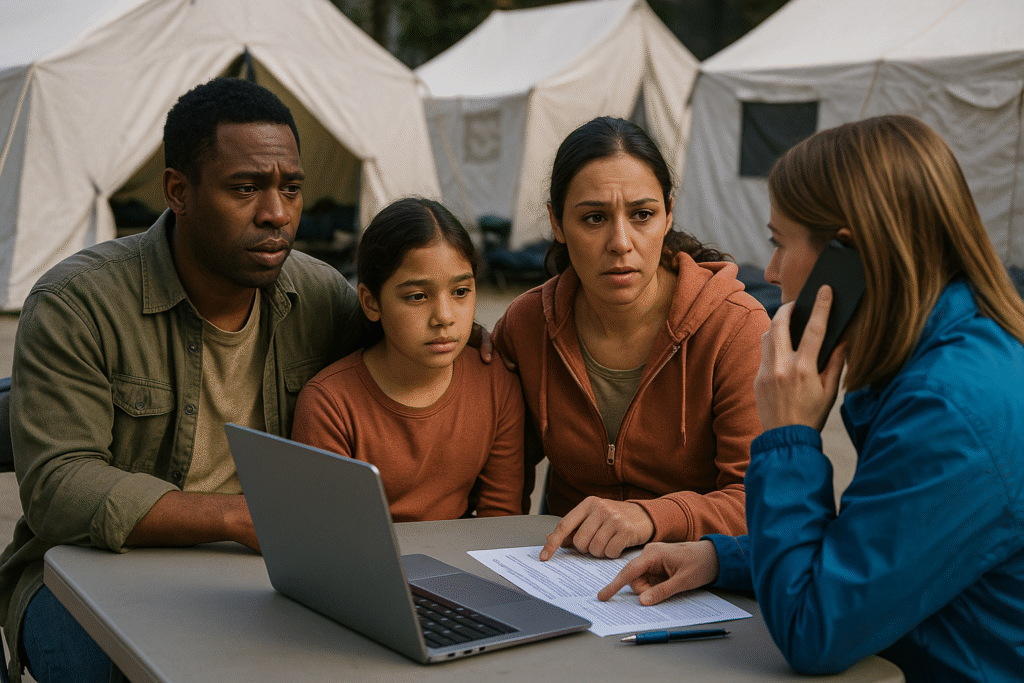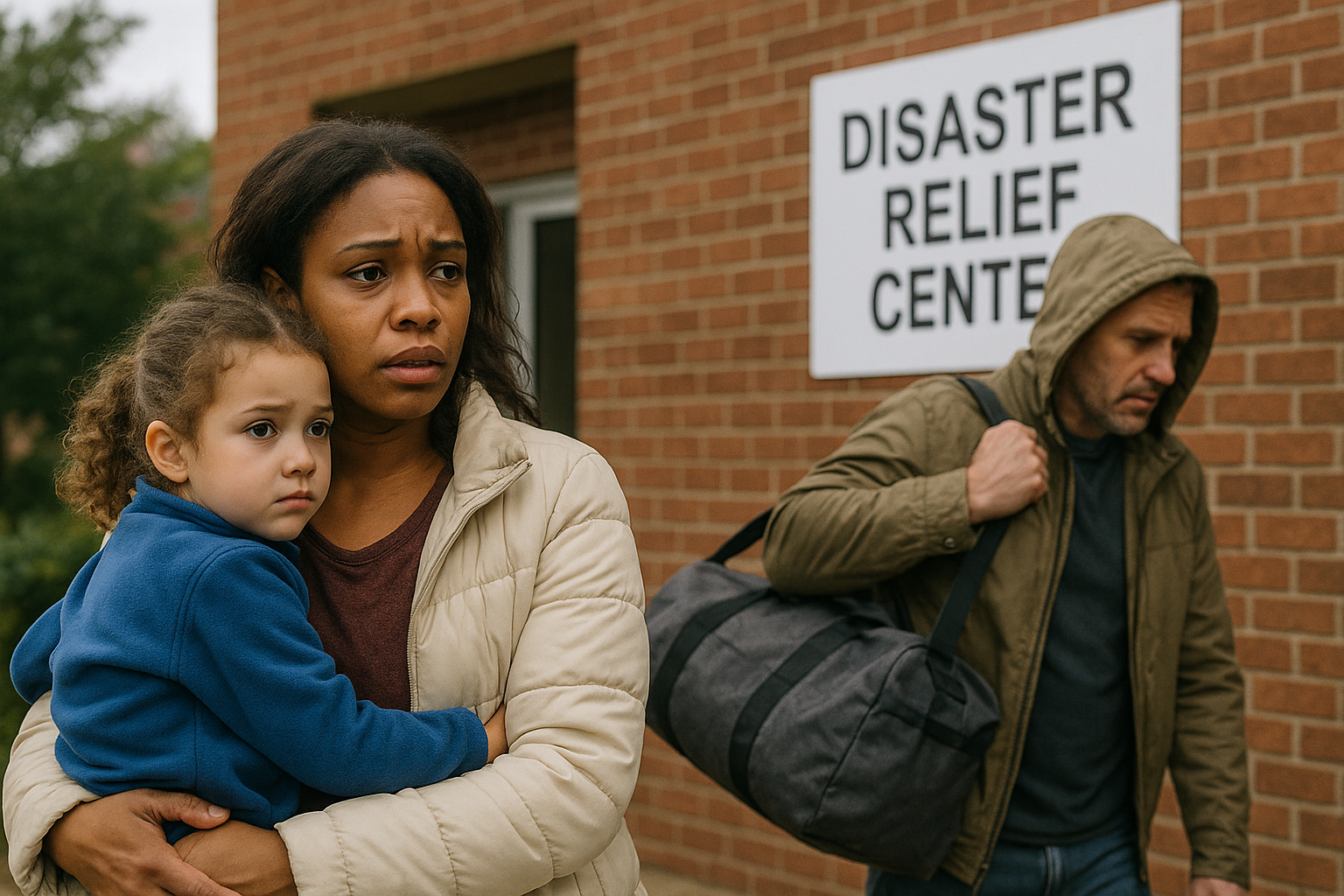Shelter After a Disaster: When disaster forces you from your home, finding safe shelter fast is the first priority. This clear, step-by-step guide explains exactly where to look, how to get short-term hotel help, who to call for local assistance, and what housing help you may qualify for — with links to official government and relief-agency resources.
Quick action — what to do in the first 10–60 minutes
- If you and your family are in immediate danger, call 911 now.
- If you need an emergency shelter, text
SHELTER ZIPCODEto 43362 (for example:SHELTER 01234) or open the FEMA app to find nearby open shelters. - If you must evacuate, check the Red Cross shelter map or call your local 211 service for referrals and help with housing and other needs.
1) Find an open FEMA or emergency shelter (fast)
Get Shelter After a Disaster: When a disaster is active, FEMA and local emergency managers coordinate shelter openings. Use these three quick methods to locate open shelters:
- Text
SHELTER+ your ZIP code to 43362. (Example:SHELTER 01234.) - FEMA app: open the app and look for shelter locations and Disaster Recovery Center info.
- Search online for shelters and Disaster Recovery Centers (DRCs) — many states and counties post live shelter lists during events.
When you arrive at a shelter: tell staff about medical needs, disabilities, pets, and any medications — they will help triage needs and connect you with additional services.
2) Transitional hotel stays (TSA) — FEMA can pay for short-term hotels
If you’re displaced and qualify after registering with FEMA, you may be eligible for Transitional Sheltering Assistance (TSA) — FEMA’s program that pays for brief hotel stays while you make longer-term housing plans. To use TSA you typically:
- Register with FEMA (DisasterAssistance.gov) and get a FEMA registration number.
- Use that number to search participating hotels on the FEMA hotel portal and call the hotel to reserve a room. FEMA covers room costs, taxes, and often pet fees for eligible households while the program is active.
Tip: TSA is a temporary bridge — use the hotel days to apply for longer-term housing help (SBA, FEMA housing programs, or local rental assistance).
3) Red Cross shelters & services — local, immediate options
The American Red Cross opens and lists shelters during disasters; their online shelter map shows open locations and services. Red Cross shelters typically provide safe, accessible spaces, basic meals, and referrals to local recovery services. If you’re told to evacuate, check the Red Cross map or ask local emergency staff for the nearest shelter.
4) Dial 211 for local housing help and referrals
Dialing 211 (or visiting 211.org) connects you to local resource specialists who can help locate emergency shelters, rental assistance, utility support, and other community services. 211 is available across most of the U.S., is confidential, and often operates 24/7 during disasters — a great single point of contact for immediate, local help.
When you call 211, have your ZIP code and a short description of your situation ready (number in household, pets, accessibility needs).

5) Apply for FEMA disaster housing assistance
If your area is part of a presidentially declared disaster, FEMA may offer housing assistance beyond shelters and TSA — for example, grants for temporary housing, home repair, or rental assistance. Steps:
- Register with FEMA at DisasterAssistance.gov or call 1-800-621-3362.
- Document damage (photos, receipts) and provide proof of identity and occupancy when requested.
- Follow FEMA’s guidance on application status and next steps.
Note: FEMA assistance often supplements private insurance and other programs; it does not always replace lost property value.
6) State & local programs — LIHEAP and other help for shelter-related needs
Some state Low Income Home Energy Assistance Programs (LIHEAP) and local agencies set aside emergency funds after disasters for heating/cooling and temporary shelter needs. Each office sets its own criteria — contact your state LIHEAP office or local social services to ask whether disaster-related shelter funds are available.
If you have trouble reaching them, 211 or your local Disaster Recovery Center (DRC) can often connect you to the right office.
7) Transitional & longer-term housing paths to pursue while you’re sheltered
While you’re in a shelter or hotel through TSA, start these parallel efforts ASAP:
- Apply for FEMA housing grants (if applicable) and file insurance claims.
- Contact your state or county housing agency about rental assistance, temporary housing vouchers, or disaster case management.
- Explore SBA disaster loans if your home needs repairs not fully covered by insurance (homeowners can apply for repair loans).
- Talk to local nonprofits and faith-based organizations — they may have rapid rehousing programs or housing referrals.
Starting these steps early shortens the time you rely on temporary shelter.
8) Special needs, pets, and accessibility — tell shelter staff immediately
Shelters provide accessible spaces and usually allow service animals; some can accommodate pets through programs or pet-friendly sheltering options in coordination with partners. Tell staff about mobility, medical, or dietary needs so they can prioritize appropriate placements and services. Red Cross and FEMA shelters coordinate for accessibility — don’t assume staff know until you tell them.
9) Checklist — what to bring and what to do at intake
When you arrive at a shelter or TSA hotel, bring if possible:
- Photo ID and proof of address / occupancy (utility bill, lease, or mail).
- FEMA registration number (if you registered).
- Medication list and current prescriptions.
- Any documents/photos of damage (insurance claim info).
- Phone numbers for family, employer, insurance, and caseworkers.
- Small amounts of cash, chargers, and essential clothing.
At intake: ask about meal times, pet policy, medical support, and the case manager or recovery contact person.
When sheltering ends — next housing steps
- Keep receipts and records for disaster assistance and insurance claims.
- Stay in touch with your case manager at the shelter, TSA hotel, DRC, or FEMA — they can help move you to rental assistance, temporary housing programs, or long-term recovery options.
Disclaimer: This article is informational only and does not constitute legal or financial advice. Programs, eligibility rules, and available services can change; always confirm requirements and deadlines on official government and relief-agency pages listed below before acting. Images used in this article are royalty‑free or licensed for commercial use and are provided here for illustrative purposes.
Helpful official links (clickable)
- How to find housing after a disaster — USA.gov. (USAGov)
https://www.usa.gov/disaster-housing-shelter - Transitional Sheltering Assistance (TSA) — FEMA hotel portal & TSA fact sheet. (femaemergencyhotels.com)
https://www.femaemergencyhotels.com/
https://www.fema.gov/press-release/20250121/fact-sheet-transitional-sheltering-assistance-tsa - Find open shelters — American Red Cross shelter map. (American Red Cross)
https://www.redcross.org/get-help/disaster-relief-and-recovery-services/find-an-open-shelter.html - Dial 211 for local emergency housing & services — United Way / 211. (211.org)
https://211.org - LIHEAP — emergency energy and occasional disaster shelter support information. (Administration for Children and Families)
https://acf.gov/ocs/programs/liheap
